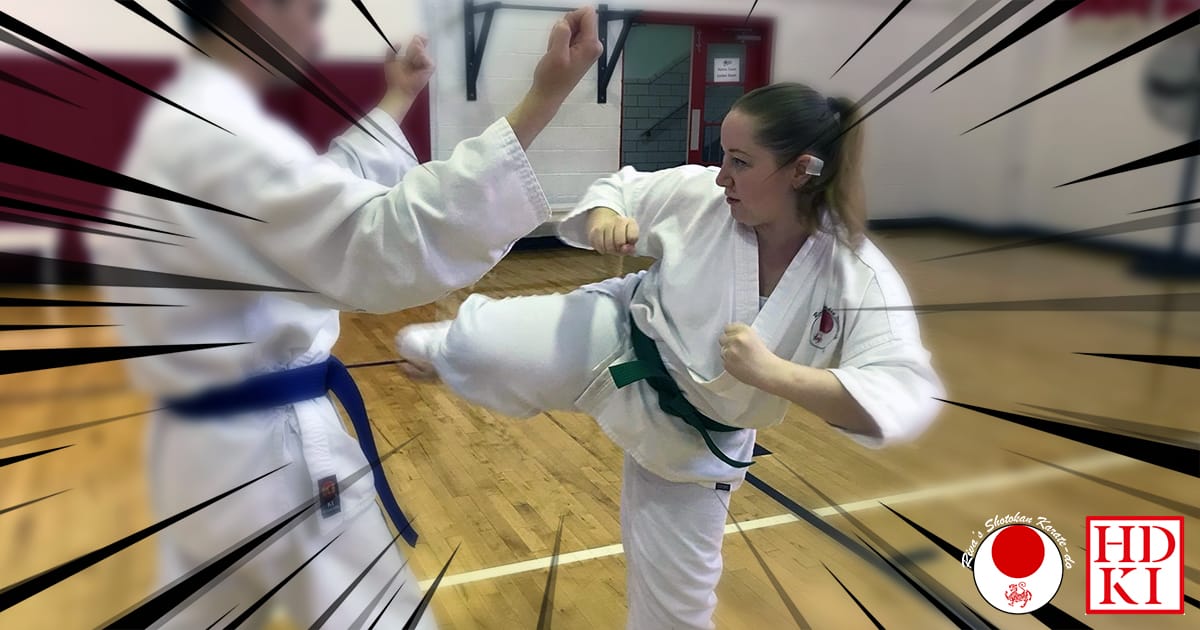
Are you trying to conceive or just discovered you’re pregnant? Congratulations fellow karate-ka! It is highly recommended to discuss it with your doctor before continuing your training in karate-do, but it is generally safe to do so throughout your entire pregnancy (if you are experiencing a low to moderate risk pregnancy).
It is also strongly encouraged to exercise during pregnancy and your karate training counts! What you’ll find is that most restrictions placed on pregnant women (like lifting heavy things) are for the benefit of you and to avoid injury to you. Your baby, especially during the first trimester, is tucked away safely inside your pelvis so the activities you do and the movements you perform won’t affect your baby’s growth and development.
Please be sure to notify your Sensei if you suspect you’re pregnant or had a positive test so that they can support you throughout. This article is the first in a series that discusses safe exercises and techniques, and what to avoid as your body creates life.
Before You’re Pregnant
If you’re trying to conceive, don’t hold back in training! The “level” or effort you put forth in your training now will become your limit when you do get that big fat positive test. Your body is accustomed to what you do now, and it is important to just maintain that when you are pregnant; overworking your body can have negative effects on you and your baby.
That Two-Week Wait
If you’ve been meticulously tracking your cycle (and even if you haven’t), it takes approximately two weeks after you’ve ovulated and possibly conceived before a home pregnancy test can appear positive.
During this time, the fertilized egg, or embryo, travels down the Fallopian tubes and implants into the wall of your uterus. Some embryos may fail to implant, in which case the pregnancy does not continue, or may attach itself somewhere outside the uterus resulting in an ectopic pregnancy. Unfortunately, there is not a whole lot you can do to ensure implantation succeeds as it is based on a number of factors that you don’t have control over, but for peace of mind, I avoided any shock, jolting, or vibration techniques that involved my core during this time.
Any abdominal and/or core focused exercises, such as sit-ups and crunches, are still okay to do, but you can do them slower or skip them altogether if you’re worried.
Welcome to the First Trimester
The first trimester of pregnancy is the most fragile time—your body is laying the ground work for the most important parts of your baby and the risk of miscarriage is over 30%, dropping slightly each day. I frequented this chart often for encouragement. Every single woman, baby, and pregnancy is unique, so the typical symptoms may not apply to you. However for me, my biggest hurdle during the first trimester was nausea and fatigue and they often banded together and prevented me from training. On the days I could make it to training, below is a list of exercises and techniques I avoided.
What to Avoid
- Contact Kumite/Sparring
I avoided this during the two-week wait as well when I first suspected I might have been pregnant, but it is imperative to stop all contact sparring where you are being attacked. I practiced kumite either alone or with 10ft between me and my uke (partner). Do not hold body shields for others. I asked my ukes to stand still in a lunge punch position like a mannequin so I could still practice distancing with my counter attacks. - Spinning Techniques
I was incredibly sensitive and was frequently nauseated in the first trimester, and I did not want to encourage it by making myself dizzy. One or two spinning back kicks was usually enough for me. If you can stomach it, you can do it. - Shock, Jolt, or Vibration Techniques
I was overly worried with the progression of my pregnancy during the two-week wait when implantation occurs, and some doctors recommend pelvic rest for those with a higher risk of miscarriage. I was a very low risk, so it was recommended to me specifically. There isn’t any definitive proof that any movements you do can interfere with implantation, but I did not want to tempt fate by shaking my mid-section around like a half empty ketchup bottle you’re trying to use. - Jumping Really Fast
For our dynamic stretches at the start of class, we sometimes jump or do jumping jacks to get the blood pumping. For the same reason that I avoided any vibration techniques, I jumped more slowly or in an awkward way where one foot was always on the ground. I usually substituted these exercises with quick, high-step marching. - Training Too Long or Too Hard
Your developing baby is incredibly selfish and takes whatever nutrients it needs from your body, and you have a finite supply (that is replenished when you eat and drink). Training uses a lot of those nutrients at a faster pace and increases the risk of dehydration for yourself, the same as if you weren’t pregnant, but now you have a baby that is depleting your stores even faster. It is very important to keep yourself hydrated because dehydration can lead to serious complications which can lead to birth defects due to lack of water and nutrition. It is not uncommon for mothers to go to the ER feeling awful only to be diagnosed with dehydration and spend the day or night receiving fluids via IV. Aside from water intake, my doctor encouraged me to keep my own heart rate below 140 as a general rule of thumb to keep stress levels low.
What you Can Still Do and/or What is Encouraged
- Dynamic & Static Stretching
In the adult classes, we do dynamic stretching at the beginning of class and static stretching at the end of class. In any trimester, stretching will not have any negative impact on the development of your baby, so stretch away! Just be aware that your joints may relax, or loosen, during pregnancy, which can increase joint pain or allow you to be a little extra flexible. My doctor told me not to continue stretching to the point where something hurts, just stretch to where it’s uncomfortable. Of course, ask your doctor to find out what’s right for you. - Abdominal Exercises
Unless you have diastasis recti (abdominal separation) from a previous pregnancy, it is perfectly safe to do exercises like sit-ups and crunches during the first trimester, especially if you want to help avoid diastasis recti from occurring during this pregnancy and to strengthen your core to help “bounce back” after delivery. - Jumping
Ironically, I included fast jumping in the avoidance list, but it is listed here too because jumping can be safe. No need to skip the jump in Heian Godan during your first trimester unless you’re worried or if your doctor recommended against it. - Kihon/Basics and Kata/Form
Keep on training as usual, just take it easy and keep in mind the points I made earlier, especially about exercising for too long or too hard. In general, it is safe for you to continue at the intensity/level you were at prior to becoming pregnant, but it is not recommended to push yourself farther!
If you have any specific questions or concerns in regards to your pregnancy, please consult your doctor! The information here is based on the average, low to moderate risk pregnancy.
This article is part of a series of karate-do & pregnancy articles written by Tessa Watkins.
